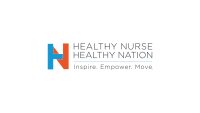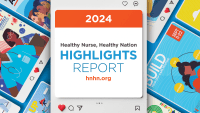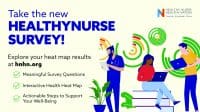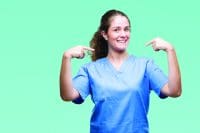What would you do if you had more energy? Would you invest some of it toward promoting your own health? Spend more time connecting with loved ones? Pursue life goals you haven’t had the time for?
With their busy, hectic lives taking care of others, many nurses feel they have nothing left for themselves. The Health Athlete/Nurse Athlete program at The Ohio State University (OSU) is designed to help nurses and other healthcare professionals uncover what’s important to them in terms of their own physical, emotional, mental, and spiritual health—and help them find ways to expand their energy and experience increased vitality and renewal.
Nurses’ health crisis
In the United States, nurses’ health and health behaviors tend to mirror those of the general population. This leaves many in the position of advising patients on health and healthy lifestyles while not following their own advice. A 2009 study found nurses’ average body mass index (BMI) was higher than that of the general U.S. adult population. A 2012 study found the rate of depressive symptoms in nurses was twice that of adults in their community.
Given that nursing educational programs emphasize health promotion and nurses are taught to be health role models, this leaves a serious disconnect between professional ideals and reality. The reason for the discrepancy between our professional responsibility to promote health and our poor self-care performance may stem from a strongly held value—that the nurse’s mission is to care for others. But must we sacrifice our own health and personal happiness to carry out our mission? I would argue we must not.
Another part of the problem is what I term nursing’s “macho culture.” All too often, I’ve heard nurses proudly state they work 12-hour shifts without taking a break, eating, or using the restroom. What’s worse, they speak with disdain of nurses who can’t or won’t work that way. This is a powerful, self-perpetuating form of social control in which recovery breaks are seen as weakness or laziness that shouldn’t be tolerated.
Finally, nurses tend to reason away their unhealthy behaviors by denying they’ll suffer ill effects (“It won’t happen to me”) or by justifying them as comforting (“What else have I got to look forward to?”).
Denying the negative impact of a stressful lifestyle, poor nutrition, lack of exercise, and worrisome clinical indicators also contributes to ill health. In her heartfelt and courageous story “Denial and heart disease,” nurse educator Joyce Grigaitis recounts how she denied cardiac symptoms for months before having an emergency cardiac catheterization. She called herself the “poster woman for denial.”
So, here we are—as overweight as the general population, twice as depressed, unwilling to take work breaks, engaging in health-risk behaviors we know are counterproductive, yet hoping we’ll somehow avoid long-term consequences of our unhealthy lifestyles. Colleagues—we can and must do better.
A way out
With my strong family history of heart disease, out-of-control blood pressure, unhealthy eating, little to no exercise, and crushing work schedule, I was Grigaitis’s male counterpart. I had a clear example of where I was headed: My father died after a myocardial infarction at age 54, yet I was following in his footsteps and couldn’t seem to stop. Something had to change, or else I’d most likely be disabled or dead in a few years.
Then I heard about the Corporate Athlete® Course, an energy management program for business executives developed by psychologists Jim Loehr and Jack Groppel during their work with elite Olympic athletes to improve performance. I attended a Corporate Athlete Course with my dean, Bernadette Melnyk, which turned out to be a life-changing experience for us both. We knew we wanted to make this opportunity available to nurses and other healthcare professionals.
Taking stock, making plans
The Health Athlete/Nurse Athlete program at OSU College of Nursing, which is based on the Corporate Athlete Course, uses the same focus on energy management but is customized to address the unique challenges and needs of the healthcare workforce. Participants examine their goals and values relative to their spiritual, mental, emotional, and physical development. This approach uses the power of one’s “story”—what you tell yourself about why your circumstances occur—to change one’s behavior. Participants learn how to better manage their energy through simple techniques, exercise, and nutrition management.
The Health Athlete/Nurse Athlete program, emphasizes the importance of “facing the truth” in the four energy spheres: physical, emotional, mental, and spiritual. To face your own truth, follow the steps below:
1 Know your numbers—and believe them.
If you’ve never done so, obtain your lipid profile, glycated hemoglobin level, C-reactive protein level, and vitamin D level to establish a baseline of your overall cardiac and metabolic health. Even if you’re healthy, knowing your baseline levels will help you monitor changes over time and spot problems early. For men older than age 35 and women older than age 45, the U.S. Preventive Services Task Force recommends basic screening annually. Persons below these cut-off ages without clinical indications for more frequent screenings should obtain these levels every 5 years. Of course, if you have other conditions that require monitoring, be sure to follow up with your primary care provider as needed.
2 Calculate your BMI and estimate your body fat percentage.
If you don’t already know your BMI, you’ll find it easy to calculate. Just type your height and weight into the calculator at http://nhlbisupport.com/bmi/. BMI is an estimation of body fat percentage (BFP); however, results can vary widely depending on your body type and fitness level. So it’s more accurate to obtain BFP through more direct measures, which range from home versions of electrical impedance scales to underwater weighing (hydrodensitometry, the most accurate way to measure BFP). Each method has advantages, drawbacks, and associated costs. Also, availability may vary. Your primary care provider, local health system, insurance company, or local university athletic department may have additional information to help you make the right choice.
3 Evaluate your nutritional habits.
Tracking your food intake is a good starting point. Health Athlete/Nurse Athlete participants consistently report that once they implement this strategy, they’re surprised by exactly what and how much they’re eating. Use whatever recording method you find easiest—from paper and pencil to online tracking to smart phone apps. The method should allow you to record what you eat, when you eat throughout the day, what you were doing at the time, and your feelings associated with eating (such as anger, guilt, or boredom). Try this for 7 days under varying conditions—work, home, recreation, parties—so you can uncover your eating patterns and emotional responses to how and what you eat.
4 Educate yourself about portion sizes.
Beware of “proportion distortion”—a phenomenon that leads people to overeat without consciously knowing it. Proportion sizes have expanded along with our waistlines over the last 20 years. Even our plates are bigger today. One of our nutrition coaches recently said she bought an antique china cabinet, but none of her contemporary dinner plates fit inside—they were far too big! If we feel compelled to fill these larger plates with more helpings of food, it’s no wonder we gain weight without even trying. Of course, restaurant food portions have grown, too. Did you know approximately six servings of bread come with an average restaurant meal? That’s something to watch for the next time you eat out.
5 Eat light and eat often.
Babies can teach us how to eat the right way. They naturally eat frequently and only to the point of satisfaction.
Eating small meals three times daily is crucial, with two to three healthy snacks in between. If you’re tempted to skip meals, ponder whether you can truly focus on a task if you’re really hungry. Are you able to bring your full and best attention to your interactions with patients, colleagues, or family members when famished? Although most adults have created sophisticated facades that stop us from crying or screaming when hungry, our “inner baby” is distracted, upset, and impatient when we’re hungry. To be focused, compassionate, and more relaxed, fuel your body to give you the energy you need throughout the day.
6 Stress your body with periods of intense exercise.
To increase your energy, you need to expend energy through three main types of exercise—aerobic, strength training, and flexibility. (See Exercise your way to better health by clicking the PDF icon above.)
7 Build in recovery.
Recovery comes in many forms and should be included in your overall health program. Examples of recovery include spending time with family or friends after an intense work period, relaxing or meditating to quiet the mind, and getting adequate sleep. The biggest barrier many nurses face in getting adequate recovery time is their mindset: If you think you must sacrifice your own health and happiness to take care of others, take pride in never taking a break at work, have convinced yourself no one else can do the job like you do it—you’re on the road to burnout, illness, or a disabling injury. Remind yourself you can’t give from “empty.” You have to “own” that recovery is important for your health and you deserve it, just like the rest of the human race.
Moving forward
In our 2-day workshops at OSU, we’ve seen tremendous breakthroughs for nurses and other healthcare professionals who follow these seven principles. But it takes courageous self-examination to make changes in service of your own health. Ultimately, you will benefit—and so will your loved ones, your patients, and your colleagues.
Selected references
Gregaitis J. Denial and heart disease. Telegram & Gazette. February 28, 2012. www.telegram.com/article/20120228/NEWS/102289935/1020. Accessed October 23, 2012.
Human Performance Institute. The Corporate Athlete Course® Workbook. Author: Orlando, FL; 2011.
Letvak S, Ruhm CJ, McCoy T. Depression in hospital-employed nurses. Clin Nurse Spec. 2012;26(3):177-182.
Tong EK, Strouse R, Hall J, Kovac M, Schroeder SA. National survey of U.S. health professionals’ smoking prevalence, cessation practices, and beliefs. Nicotine Tob Res. 2012;12(7):724-33.
Zapka JM, Lemon SC, Magner RP, Hale J. Lifestyle behaviours and weight among hospital-based nurses. J Nurs Manag. 2009:17(7):853-60.
David P. Hrabe is executive director of Academic Innovations and Partnerships and associate professor of clinical nursing at The Ohio State University College of Nursing in Columbus. To learn more about attending a Health Athlete/Nurse Athlete workshop at OSU or bringing the workshop to your organization, please visit http://healthathlete.org.



















3 Comments.
Excellent article and suggestions. Way to many nurses who are overweight. My facility is making a big effort towards employee health promotion, I like this program because is nurse focus. Sharing information with my facility Wellness program.
I’m interested in developing and researching hospital based interval exercise programs for nurses; in particular, kettle bell swings and 15 minute plyometric exercises.
Of the 3 nutrition related steps outlined here, none address the “quality” of the food ingested. As a farmer and local food entrepreneur, I encourage nurses to join their local food activists to access fresh, organic (unpoisoned) nutrient dense ingredients (www.prairiebirthdayfarm.com).